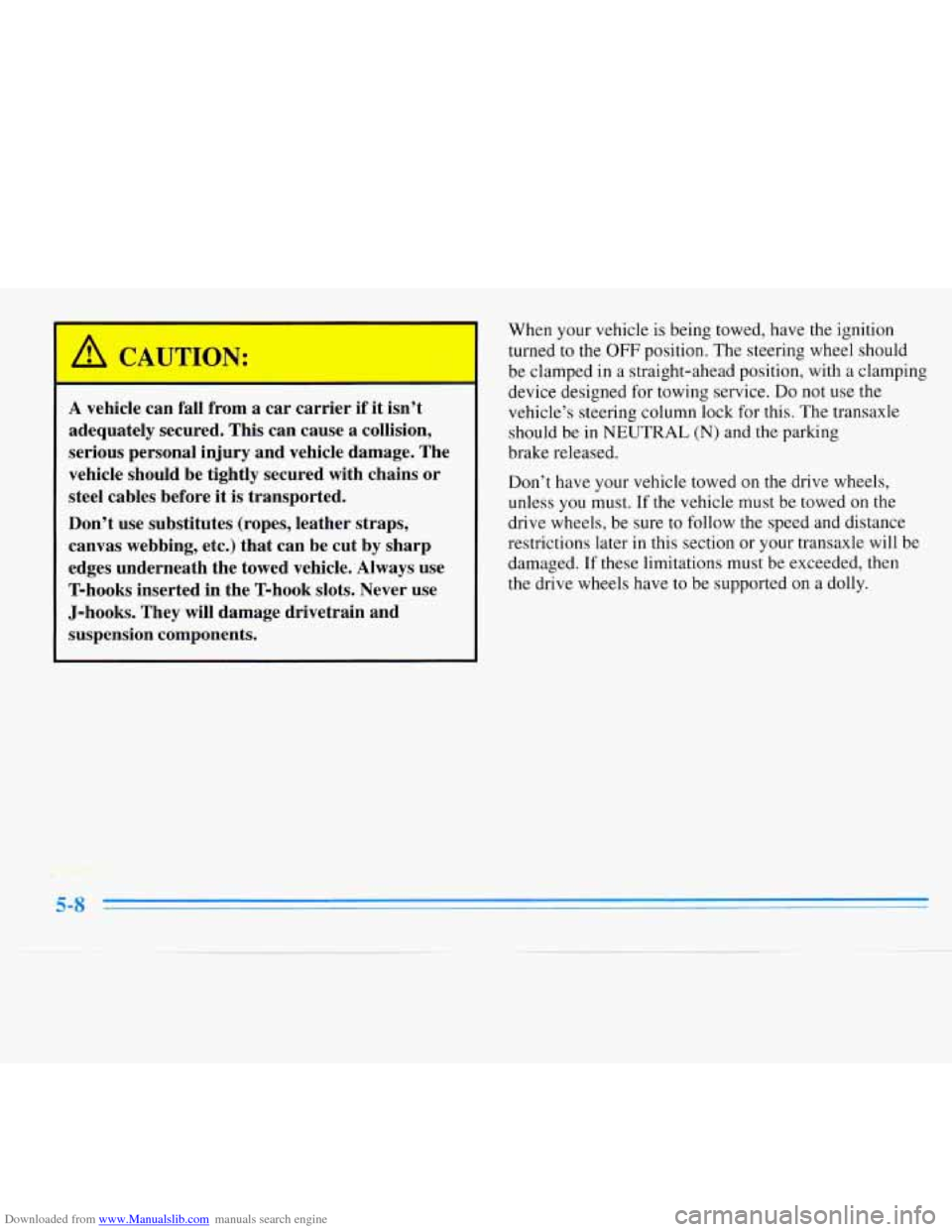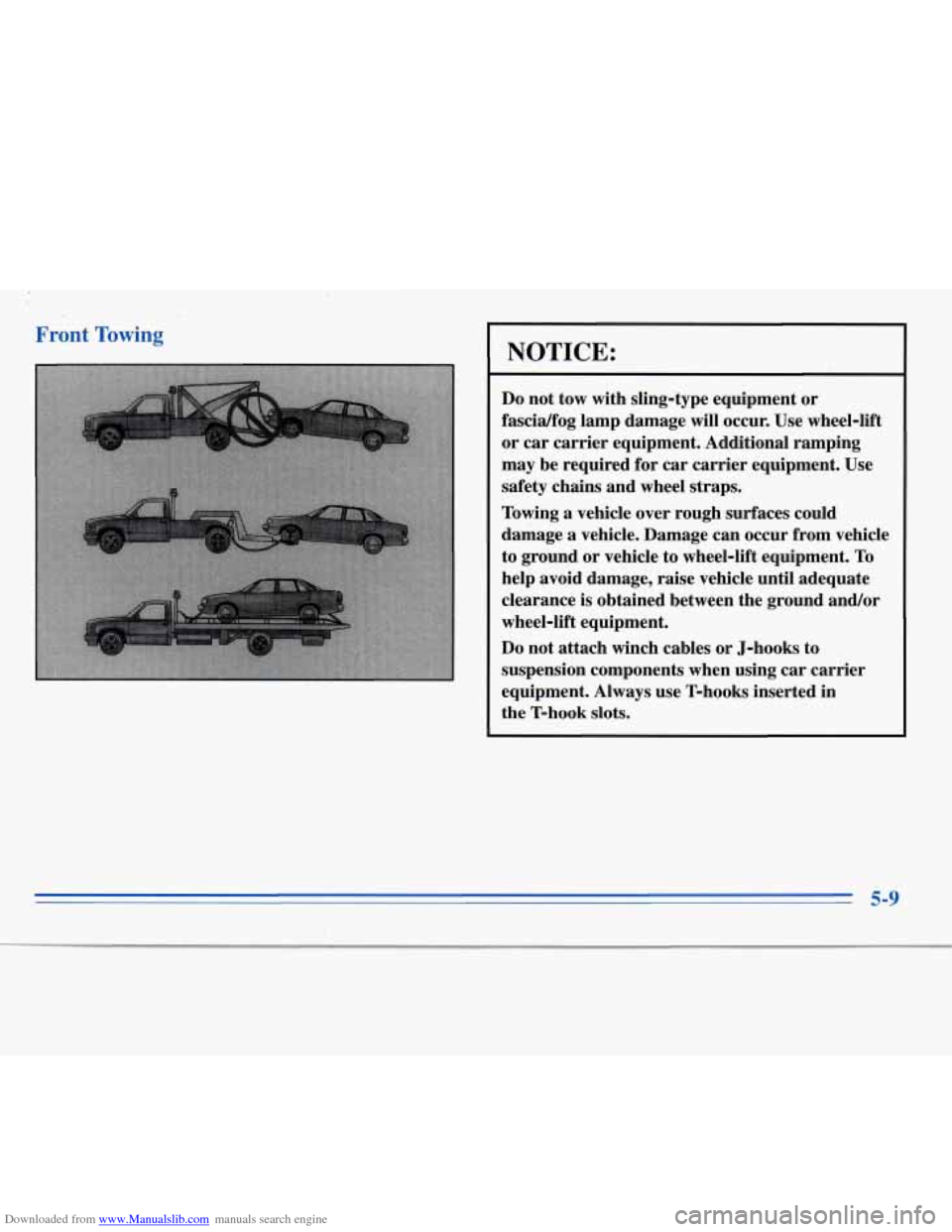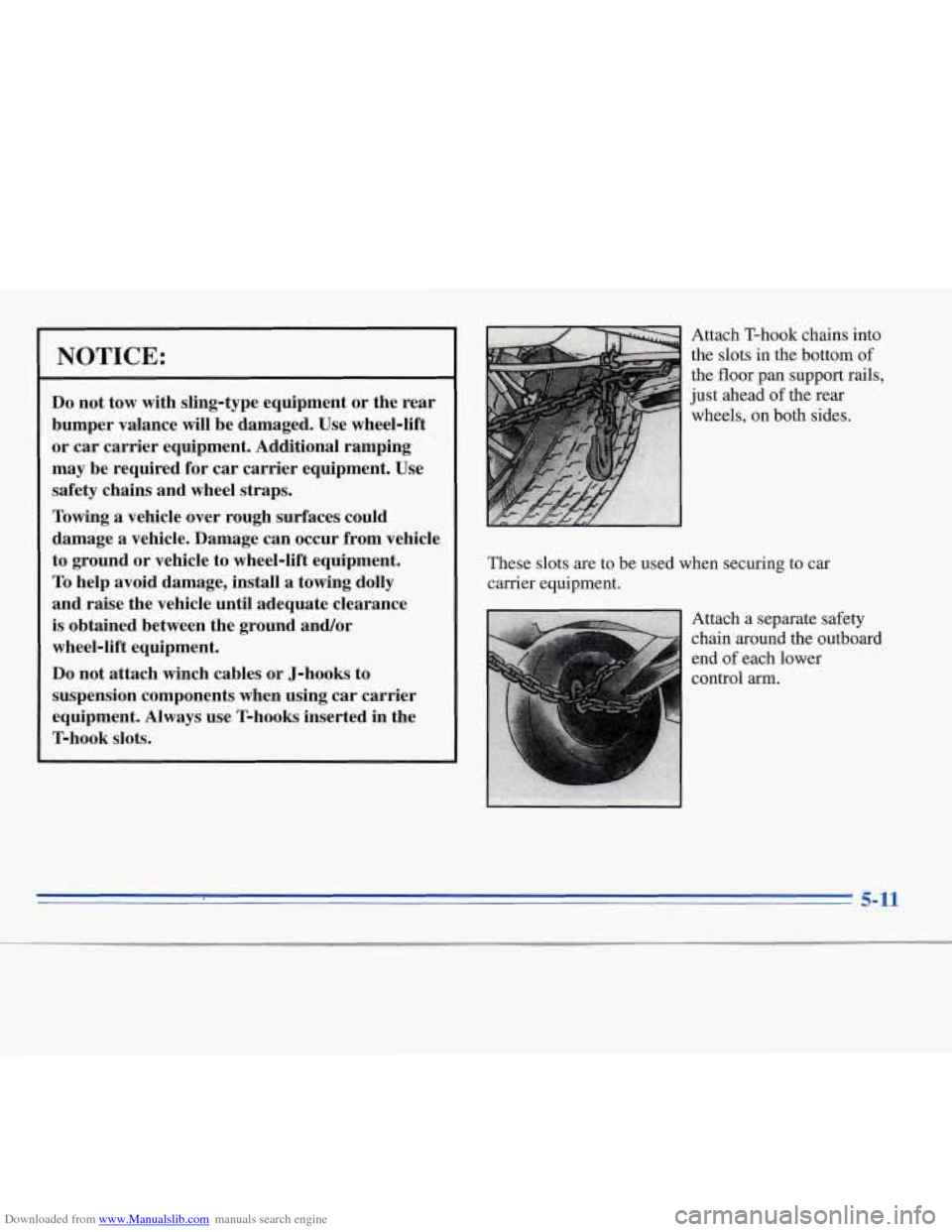1996 CHEVROLET MONTE CARLO suspension
[x] Cancel search: suspensionPage 180 of 340

Downloaded from www.Manualslib.com manuals search engine A vehicle can fall from a car carrier if it isn’t
adequately secured. This can cause a collision,
serious personal injury and vehicle damage. The
vehicle should be tightly secured with chains or
steel cables before it is transported.
Don’t use substitutes (ropes, leather straps,
canvas webbing, etc.) that can be cut by sharp
edges underneath the towed vehicle. Always use
T-hooks inserted in the T-hook slots. Never use
J-hooks. They will damage drivetrain and
suspension components.
When your vehicle is being towed, have the ignition
turned to the
OFF position. The steering wheel should
be clamped in a straight-ahead position, with a clamping
device designed for towing service. Do not
use the
vehicle’s steering column lock for this. The transaxle
should be
in NEUTRAL (N) and the parking
brake released.
Don’t have your vehicle towed on the drive wheels,
unless you must. If the vehicle must be towed on the
drive wheels, be sure to follow the speed and distance
restrictions later in this section or your transaxle will be
damaged.
If these limitations must be exceeded, then
the drive wheels have
to be supported on a dolly.
Page 181 of 340

Downloaded from www.Manualslib.com manuals search engine Front Towing
NOTICE:
Do not tow with sling-type equipment or
fascidfog lamp damage
will occur. Use wheel-lift
or car carrier equipment. Additional ramping
may be required for car carrier equipment. Use
safety chains and wheel straps.
Towing
a vehicle over rough surfaces could
damage a vehicle. Damage can occur from vehicle
to ground or vehicle to wheel-lift equipment. To
help avoid damage, raise vehicle until adequate
clearance
is obtained between the ground and/or
wheel-lift equipment.
Do not attach winch cables or J-hooks to
suspension components when using car carrier
equipment. Always use T-hooks inserted in
the T-hook slots.
Page 183 of 340

Downloaded from www.Manualslib.com manuals search engine NOTICE:
Do not tow with sling-type equipment or the rear
bumper valance will be damaged. Use wheel-lift
or car carrier equipment. Additional ramping
may be required for car carrier equipment. Use
safety chains and wheel straps.
Towing
a vehicle over rough surfaces could
damage
a vehicle. Damage can occur from vehicle
to ground or vehicle to wheel-lift equipment.
To help avoid damage, install a towing dolly
and raise the vehicle until adequate clearance
is obtained between the ground and/or
wheel-lift equipment.,
Do not attach winch cables
or J-hooks to
suspension components when using car carrier
equipment.
Always use T-hooks inserted in the
T-hook slots.
Attach T-hook chains into
the slots in the bottom
of
the floor pan support rails,
just ahead
of the rear
These slots are to be used when securing to car
carrier equipment.
Attach
a separate safety
chain around the outboard
end
of each. lower
control
arm.
5-11
Page 312 of 340

Downloaded from www.Manualslib.com manuals search engine Part C: Periodic Maintenance
Inspections
Listed below are inspections and services which should be
performed at least twice
a year (for instance, each spring
and fall). You should let your
GM dealer’s service
department or other qualified service center do these jobs.
Make sure any necessary repairs are completed at once.
Proper procedures to perform these services may be
found
in a Chevrolet service manual. See “Service and
Owner Publications”
in the Index.
Steering, Suspension and Front-Wheel-Drive
Axle Boot and Seal Inspection
Inspect the front and rear suspension and steering
system for damaged, loose or missing parts, signs of
wear, or lack of lubrication. Inspect the power steering
lines and hoses for proper hookup, binding, leaks,
cracks, chafing, etc. Clean and then inspect the drive
axle boot seals for damage, tears or leakage. Replace
seals if necessary.
Exhaust System Inspection
Inspect the complete exhaust system. Inspect the body
near the exhaust system.
Look for broken, damaged,
missing or out-of-position parts
as well as open seams, holes, loose connections,
or other conditions which
could cause
a heat build-up in the floor pan or could let
exhaust fumes into the vehicle. See “Engine Exhaust’’ in
the Index.
Radiator and Heater Hose Inspection
Inspect the hoses and have them replaced if they are
cracked, swollen or deteriorated. Inspect all pipes,
fittings and clamps; replace
as needed.
Throttle Linkage Inspection
Inspect the throttle linkage for interference or binding,
and for damage or missing parts. Replace parts
as
needed. Replace any cables that have high effort or
excessive wear.
Do not lubricate accelerator and cruise
control cables.
Brake System Inspection
Inspect the complete system. Inspect brake lines and
hoses for proper hookup, binding, leaks, cracks, chafing,
etc. Inspect disc brake pads for wear and rotors for
surface condition. Also inspect drum brake linings for
wear and cracks. Inspect other brake parts, including
drums, wheel cylinders, calipers, parking brake, etc.
Check parking brake adjustment. You may need to have
your brakes inspected more often if your driving habits
or conditions result
in frequent braking.
Page 333 of 340

Downloaded from www.Manualslib.com manuals search engine Ignition Switch ................................ 2-10
Illumination. Sustained Interior .................... 2-32
Inflation. Tire
.................................. 6-37
Inside Daymight Rearview Mirror
................. 2-33
Brakesystem
................................ 7-40
Exhaust Systems
............................. 7-40
Front-Wheel-Drive Axle Boot
.................. 7-40
Front-Wheel-Drive Axle Seal
.................... 7-40
Radiator and Heater Hose
...................... 7-40
Suspension
.................................. 7-40
Throttle Linkage
.............................. 7-40
Instrument Panel
............................... 2-38
Brightness Control
............................. 2-31
Cleaning .................................... 6-47
FuseBlock
.................................. 6-53
Interior Lamps 2-3
1
Inspections .................................... 7-40
Steering
.................................... 7-40
Cluster
..................................... 2-40
.................................
.................................... J ack. Tire 5-22
Jump Starting 5-2
...................................
Key Lock Cylinders Service ..................... 7-37
Key Reminder Warning
.......................... 2- 10
Keys ........................................... 2-1 Lamps
........................................ 2-30
Courtesy
.................................... 2-31
Interior 2-31 OnReminder
................................ 2-30
Latches, Seatback 1-5
Leaving Your Vehicle
............................. 2-3
Leaving Your Vehicle with
the Engine Running ....... 2-19
Lighter 2-36
Lights Air Bag Readiness
....................... 1-18, 2-43
Anti-Lock Brake System Active
............. 2-46, 4-8
Anti-Lock Brake System Warning
............ 2-45, 4-6
Charging System
............................. 2-43
.....................................
................................
.......................................
Brake System Warning ........... 1 ............. 2-44
Engine Coolant Temperature
.................... 2-46 - lnterior .............
Low Coolant Warning .
Low Oil Level Warning
Oil Warning
.........
Safety Belt Reminder . .
Security ............
Service Engine Soon . .
Loading Your Vehicle ... ..
........................ 2-31 ~-
........................ 2-47
........................ 2-51
........................ 2-50
.................... 1-7, 2-42
........................ 2-52
........................ 2-48
........................ 4-26
Locks
......................................... 2-3
Cylinders
................................... 7-37 -
Labels 4-26
Certification 4-27
Service Parts Identification
..................... 6-52
Tire-Loading Information
...................... 4-26
Vehicle Identification Number
................... 6-52
.......................................
.................................
9-5
..
1
Door ....................
Key Lock Cylinder Service .
Power Door .............
Steering Column Lock Check
Trunk
..................
Low Coolaat Warning Light . .
Low Oil Level Warning Light .
Lubricants and Fluids ........
Lubrication Service. Body ....
..................... 2-3
....................... 7.
...................... 2-3
................... 7-39
..................... 2-6
.................... 2-47
..................... 2-51
.................... 7-41
.................... 7-37